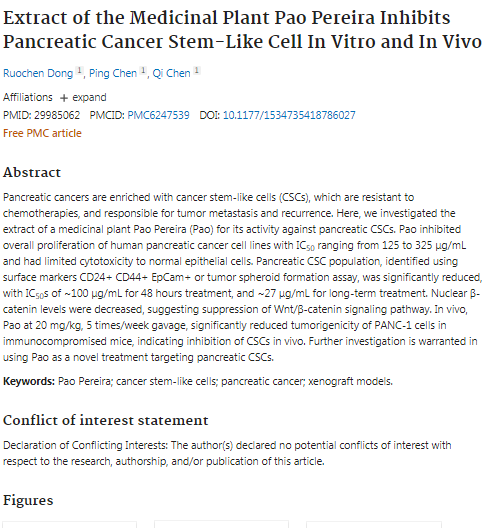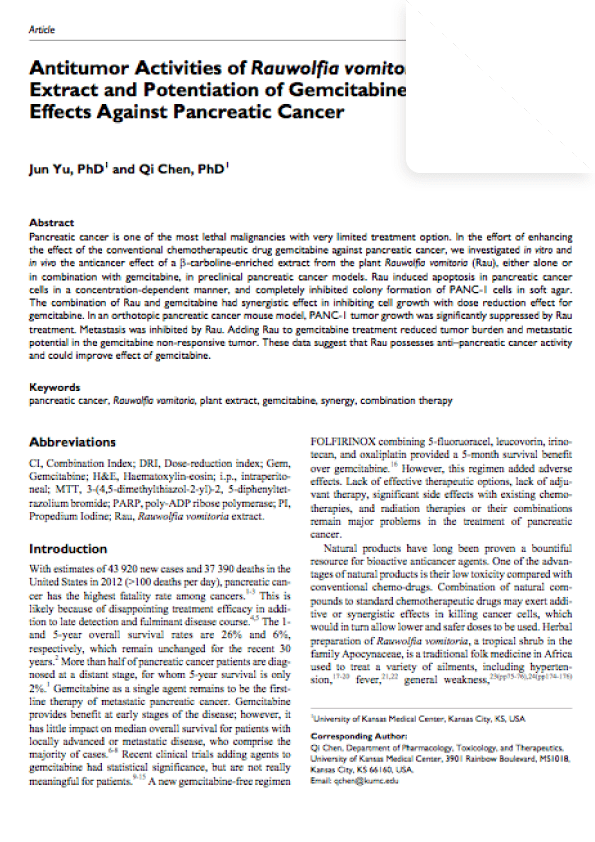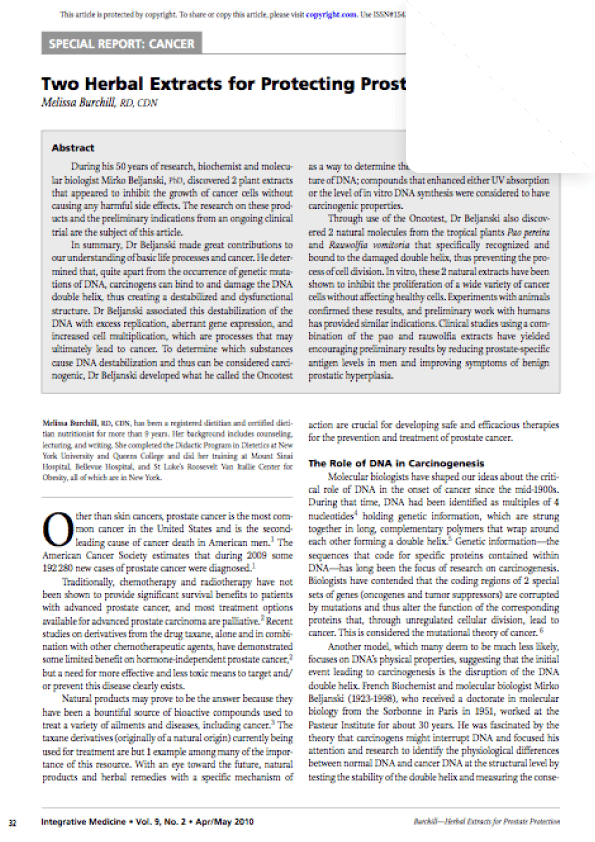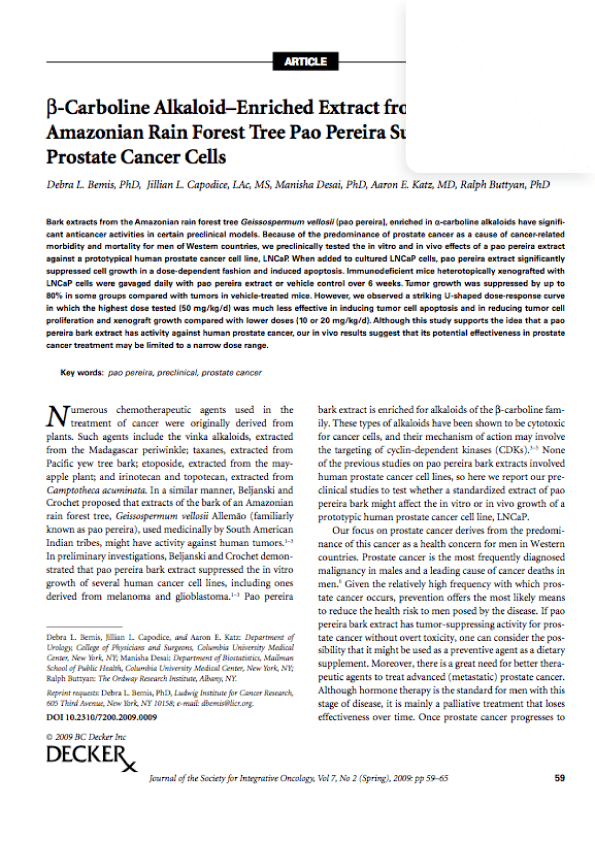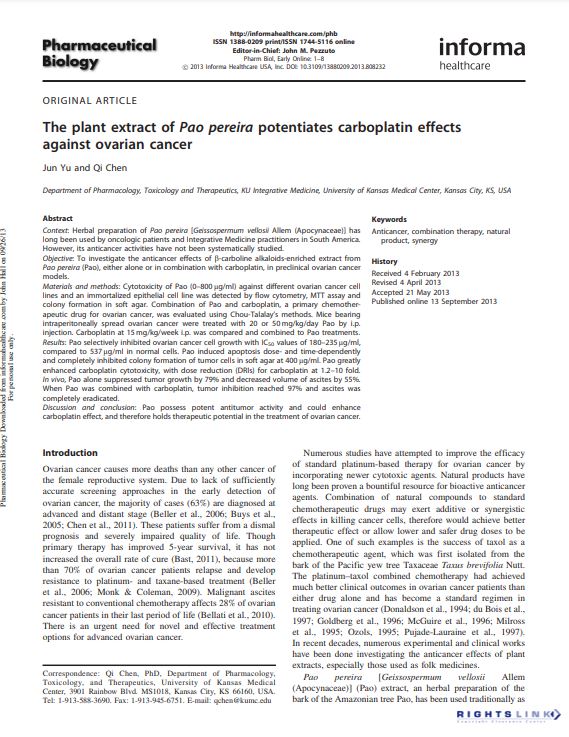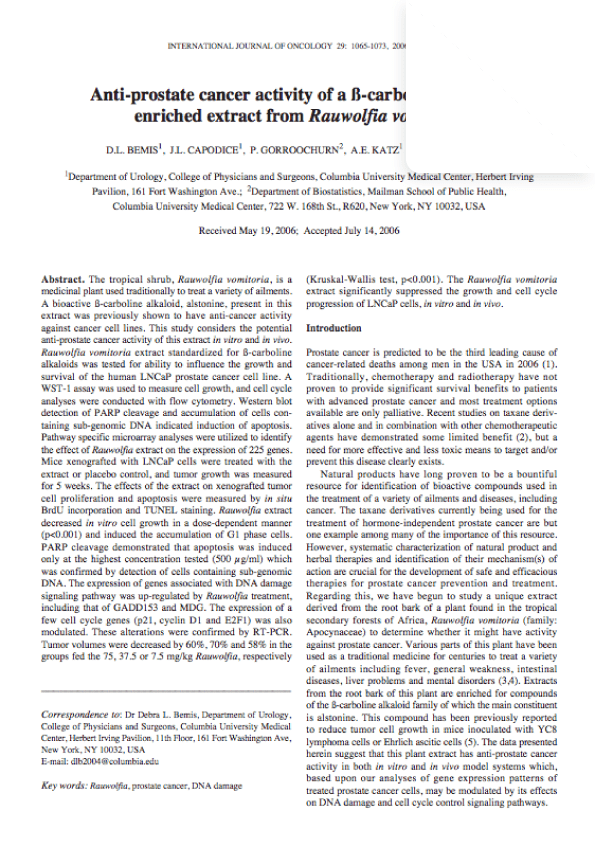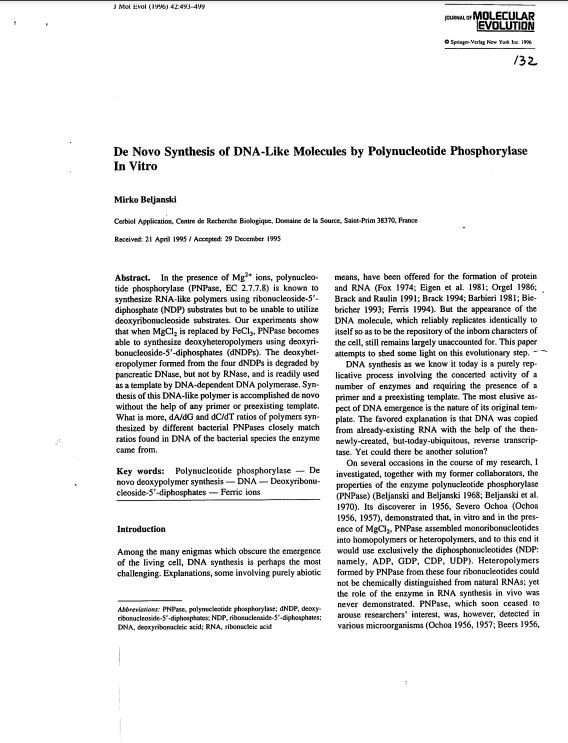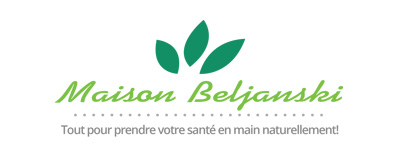Archives Publications
Titre de la publication: "Inhibition du cancer du pancréas et potentialisation des effets de la gemcitabine avec l'extrait de Pao Pereira"
Publié par " Integrative Cancer Therapies "
L'extrait de Pao pereira a induit une apoptose dose-dépendante dans toutes les lignées cellulaires de cancer du pancréas testées. La combinaison d'extraits de Pao et de Gemcitabine a eu un effet synergique dans l'inhibition de la croissance des cellules cancéreuses. Les souris atteintes de tumeurs pancréatiques ont été traitées avec l'extrait Pao et de la gemcitabine, seuls ou en association. Bien que la gemcitabine n'ait pas fourni d'inhibition significative, le traitement par Pao a supprimé de manière significative la croissance tumorale de 70 à 72% et de 78% lorsqu'il est associé à la gemcitabine.
L’extrait de Pao pereira a induit une apoptose dose-dépendante dans toutes les lignées cellulaires de cancer du pancréas testées. La combinaison d’extraits de Pao et de Gemcitabine a eu un effet synergique dans l’inhibition de la croissance des cellules cancéreuses. Les souris atteintes de tumeurs pancréatiques ont été traitées avec l’extrait Pao et de la gemcitabine, seuls ou en association. Bien que la gemcitabine n’ait pas fourni d’inhibition significative, le traitement par Pao a supprimé de manière significative la croissance tumorale de 70 à 72% et de 78% lorsqu’il est associé à la gemcitabine.
Titre de la Publication: "Activités antitumorales de l'extrait de Rauwolfia vomitoria et potentialisation des effets de la gemcitabine contre le cancer du pancréas"
Publié par " Integrative Cancer Therapy "
by Jun Yu, PhD and Qi Chen, PhD
Integrative Cancer Therapy. 2014 Apr 24;13(3):217-225.
The fourth publication from the scientific collaboration between the Beljanski Foundation and Kansas University Medical Center has been released. It shows, in vitro and in vivo, the effectiveness of Rauwolfia vomitoria (the extract prepared according to Dr. Mirko Beljanski’s proprietary process) on pancreatic cancer cells. This publication also confirms – if confirmation were needed – the non-toxicity of Rauwolfia (“Rau”), on healthy cells, its selective effect against cancer cells, and its excellent synergistic action with Gemcitabine chemotherapy. This study, conducted with extracts provided by Natural Source International, Ltd. is now available on The Beljanski Foundation website.
For the purpose of this study, pancreatic cancer cells were inoculated into four groups of mice (control group treated with saline solution, mice treated with Gemcitabine alone, mice treated with Rauwolfia alone, and mice with combination treatment of Gemcitabine and Rauwolfia). As the tumors did not respond to Gemcitabine, Rauwolfia at either 20 mg/kg or 50 mg/kg provided observable inhibition in tumor growth. The combination of Gemcitabine + Rauwolfia at both doses also inhibited tumor progression. Notably, there were 2 mice in the Gemcitabine + Rauwolfia 50 mg/kg group that had complete tumor regression, an effect that was not observed in any other treatment group.
Necropsy confirmed the imaging results at the end of the treatment. Gemcitabine at the dose used did not provide any reduction in tumor weight, when Rauwolfia alone decreased tumor weight by 53% at the daily dose of 20 mg/kg, and 46% at the daily dose of 50 mg/kg, compared with saline-treated control. By combining Rauwolfia with Gemcitabine, the decrease in tumor weight was 56% at both Rauwolfia doses. The improvement in tumor inhibition provided by the combination was significant compared with that of Gemcitabine alone.
On assessing tumor metastasis, 12% of mice in the control group (saline-treated) and in the Rauwolfia 20 mg/kg group did not form metastasis, whereas all mice in Gemcitabine group formed metastasis. The percentage of metastasis free mice increased to 40% with both Rau 50 mg/kg treatment and Gemcitabine + Rauwolfia treatment, suggesting that Rauwolfia provided benefit in reducing metastatic potential while Gemcitabine did not.
None of the mice demonstrated observable toxicity associated with the treatments. At the end of the experiments, major organs (kidney, liver, and spleen) were subjected to hematoxylin and eosin staining and histopathological analysis. No tissue damage was detected in the treatment groups, and there were no significant differences between the control group and the treated group. This data demonstrated that Rauwolfia at the dose used, either alone or combined with Gemcitabine, was effective and, at the same time, low in toxicity.
This would open an avenue to reduce toxicity associated with chemotherapy.
Abstract
Pancreatic cancer is one of the most lethal malignancies with very limited treatment option. In the effort of enhancing the effect of the conventional chemotherapeutic drug gemcitabine against pancreatic cancer, we investigated in vitro and in vivo the anticancer effect of a β-carboline-enriched extract from the plant Rauwolfia vomitoria (Rau), either alone or in combination with gemcitabine, in preclinical pancreatic cancer models. Rau induced apoptosis in pancreatic cancer cells in a concentration-dependent manner, and completely inhibited colony formation of PANC-1 cells in soft agar.
The combination of Rau and gemcitabine had synergistic effect in inhibiting cell growth with dose reduction effect for gemcitabine. In an orthotopic pancreatic cancer mouse model, PANC-1 tumor growth was significantly suppressed by Rau treatment. Metastasis was inhibited by Rau. Adding Rau to gemcitabine treatment reduced tumor burden and metastatic potential in the gemcitabine non-responsive tumor. These data suggest that Rau possesses anti–pancreatic cancer activity and could improve effect of gemcitabine.
In preclinical pancreatic cancer models, Rauwolfia vomitoria extract induced apoptosis in pancreatic cancer cells in a dose-dependent manner. The combination of Rauwolfia extract and gemcitabine had a synergistic effect in inhibiting cell growth. Pancreatic tumor growth was significantly suppressed by Rauwolfia treatment and metastasis was inhibited as well. Adding Rauwolfia extract to gemcitabine treatment further reduced tumor burden and metastatic potential in the gemcitabine resistant tumors. These data suggest that Rau possesses anti–pancreatic cancer activity and could improve the effect of gemcitabine.
Titre de la Publication: "Deux extraits de plantes pour protéger l'ADN des cellules de la prostate"
Publication sur ” Townsend Letter “
A clinical trial began in 2006 and enrolled some 42 patients with elevated prostate specific antigen (PSA) readings (averaging 8 to 10 on the PSA scale) and a negative biopsy a group of men that in the industrialized world numbers in the millions.
One of the primary goals of the clinical trial was to determine if the plant extracts were safe. The research team did a dose escalation trial. The trial started at two capsules but has gone much higher, and so far all doses tested have been without side effects.
“We now know that this combination of Beljanski’s extracts can significantly lower PSAs in a 12-month period. Also we have had very few patients convert to prostate cancer and have found a number of patients who have had a dramatic improvement in their urinary symptoms. Men are clearly having less frequency, better streams and better flow rates. They are not getting up at night as often.
“The bottom line is that it appears our early results are reason to be very encouraged by Beljanski’s extracts’ ability to lower PSA and help older men urinate better, too.”
So how important are Beljanski’s findings to men’s health? “There are a lot of men undergoing PSA screening,” Dr. Katz said. “The PSA supposedly stands for “prostate specific antigen” but I say it is more accurately “patient stimulated anxiety.” When a man’s PSA is elevated, there could be many reasons for this, having nothing to do with cancer. But what we know now is that these cells that are growing can develop into cancer, and we would like to stop them from doing so. Also if the cells keep growing even in benign fashion, they will grow around the urethra and push in on it and provoke urinary symptoms in men. That’s where we want to lower the growth and division of prostate cells and that’s what we think we have shown with the extracts.
Source: “The Columbia Connection” by L.Stephen Coles, MD., Ph.D. The Doctors’ prescription for healthy living
Abstract
During his 50 years of research, biochemist and molecular biologist Mirko Beljanski, PhD, discovered 2 plant extracts that appeared to inhibit the growth of cancer cells without causing any harmful side effects. The research on these products and the preliminary indications from an ongoing clinical trial are the subject of this article. In summary, Dr Beljanski made great contributions to our understanding of basic life processes and cancer. He determined that, quite apart from the occurrence of genetic mutations of DNA, carcinogens can bind to and damage the DNA double helix, thus creating a destabilized and dysfunctional structure. Dr Beljanski associated this destabilization of the DNA with excess replication, aberrant gene expression, and increased cell multiplication, which are processes that may ultimately lead to cancer. To determine which substances cause DNA destabilization and thus can be considered carcinogenic, Dr Beljanski developed what he called the Oncotest as a way to determine the effect of a compound on the structure of DNA; compounds that enhanced either UV absorption or the level of in vitro DNA synthesis were considered to have carcinogenic properties. Through use of the Oncotest, Dr Beljanski also discovered 2 natural molecules from the tropical plants Pao pereira and Rauwolfia vomitoria that specifically recognized and bound to the damaged double helix, thus preventing the process of cell division. In vitro, these 2 natural extracts have been shown to inhibit the proliferation of a wide variety of cancer cells without affecting healthy cells. Experiments with animals confirmed these results, and preliminary work with humans has provided similar indications. Clinical studies using a combination of the pao and rauwolfia extracts have yielded encouraging preliminary results by reducing prostate-specific antigen levels in men and improving symptoms of benign prostatic hyperplasia.
Titre de la Publication: " L'extrait de l'arbre de la forêt amazonienne Pao Pereira, enrichi en alcaloïde β-carboline, supprime les cellules cancéreuses de la prostate."
Publié par " Journal of the Society for Integrative Oncology "
Spring 2009 - “β-Carboline Alkaloid-Enriched Extract from the Amazonian Rain Forest Tree Pao Pereira Suppresses Prostate Cancer Cells"
by Debra L. Bemis, PhD, Jillian L. Capodice, LAc, MS, Manisha Desai, PhD, Aaron E. Katz, MD, Ralph Buttyan, PhD - Journal of the Society for Integrative Oncology, Vol 7, No2
Bark extracts from the Amazonian rain forest tree Geissospermum vellosii (pao pereira), enriched in B-carboline alkaloids have significant anticancer activities in certain preclinical models. Because of the predominance of prostate cancer as a cause of cancer-related morbidity and mortality for men of Western countries, the research team at Columbia University preclinically tested the in vitro and in vivo effects of a pao pereira extract against a prototypical human prostate cancer cell line, LNCaP. When added to cultured LNCaP cells, pao pereira extract significantly suppressed cell growth in a dose-dependent fashion and induced apoptosis. Immunodeficient mice heterotopically xenografted with LNCaP cells were gavaged daily with pao pereira extract or vehicle control over 6 weeks. Tumor growth was suppressed by up to 80% in some groups compared with tumors in vehicle-treated mice
Prostate cancer is the most frequently diagnosed malignancy in males and a leading cause of cancer deaths in men.6 Given the relatively high frequency with which prostate cancer occurs, prevention offers the most likely means to reduce the health risk to men posed by the disease. If pao pereira bark extract has tumor-suppressing activity for prostate cancer without overt toxicity, one can consider the possibility that it might be used as a preventive agent as a dietary supplement.
Abstract

Titre de la Publication: "L'extrait végétal de Pao Pereira potentialise les effets du carboplatine contre le cancer de l'ovaire."
Publié dans " Informa Healthcare "
Jun Yu, PhD, Qi Chen, PhD. – ISSN 1388-0209 print/ISSN 1744-5116 –
Pharmaceutical Biology
Des recherches récentes menées au centre médical de l'université du Kansas montrent qu'une préparation à base de plantes de Pao pereira, fournie par Natural Source International, Ltd. pourrait être extrêmement utile. Elle conclut que "In vivo, Pao pereira seul a supprimé la croissance de la tumeur de 79% et a diminué le volume de l'ascite de 55%. Lorsque le Pao pereira a été associé au carboplatine, l'inhibition de la tumeur a atteint 97 % et l'ascite a été complètement éradiquée. Pao pereira possède une puissante activité antitumorale et pourrait renforcer l'effet du carboplatine. Il présente donc un potentiel thérapeutique dans le traitement du cancer de l'ovaire."
Il s'agit d'une étude révolutionnaire si l'on considère que l'American Cancer Society estime qu'en 2013, environ 22 240 nouveaux cas de cancer de l'ovaire seront diagnostiqués et que 14 030 femmes mourront de ce cancer aux États-Unis. Selon les données, les taux de mortalité liés au cancer de l'ovaire ne se sont pas améliorés au cours des quarante années qui ont suivi la déclaration de la "guerre contre le cancer".
La préparation à base de plantes de Pao pereira est utilisée depuis longtemps par les patients et les praticiens de la médecine intégrative en Amérique du Sud. Cette étude porte sur les effets anticancéreux du Pao pereira (Pao), seul ou en combinaison avec des médicaments de chimiothérapie (carboplatine), dans des modèles précliniques de cancer de l'ovaire.
Les résultats de l'étude constituent une percée dans la recherche sur le cancer de l'ovaire!
Le Pao pereira a inhibé de manière sélective la croissance des cellules cancéreuses de l'ovaire et a induit l'apoptose (mort cellulaire programmée). Le Pao pereira a également considérablement augmenté la cytotoxicité des médicaments de chimiothérapie.
In vivo, Pao pereira seul a supprimé la croissance de la tumeur de 79% et a diminué le volume de l'ascite de 55%. Lorsque Pao pereira a été associé à la chimiothérapie, l'inhibition de la tumeur a atteint 97 % et l'ascite a été complètement éradiquée.
Les chercheurs concluent que le Pao Pereira a un potentiel thérapeutique dans le traitement du cancer de l'ovaire.
Résumé de la Publication
La préparation à base de plantes de Pao pereira [Geissospermum vellosii Allem (Apocynaceae)] est utilisée depuis longtemps par les patients en oncologie et les praticiens de la médecine intégrative en Amérique du Sud. Cependant, ses activités anticancéreuses n'ont pas été systématiquement étudiées. Objectif : Étudier les effets anticancéreux de l'extrait enrichi en alcaloïdes b-carboliniques de Pao pereira (Pao), seul ou en combinaison avec du carboplatine, dans des modèles précliniques de cancer de l'ovaire. Matériaux et méthodes : La cytotoxicité du Pao (0-800 mg/ml) contre différentes lignées cellulaires de cancer ovarien et une lignée de cellules épithéliales immortalisées a été détectée par cytométrie en flux, test MTT et formation de colonies dans de la gélose molle. La combinaison de Pao et de carboplatine, un médicament chimiothérapeutique primaire pour le cancer de l'ovaire, a été évaluée en utilisant les méthodes de Chou-Talalay. Des souris porteuses d'un cancer de l'ovaire induit par voie intrapéritonéale ont été traitées par 20 ou 50 mg/kg/jour de Pao par injection i.p.. Le carboplatine à 15 mg/kg/semaine par voie i.p. a été comparé et associé aux traitements par Pao. Résultats : Le Pao a inhibé sélectivement la croissance des cellules cancéreuses ovariennes avec des valeurs IC50 de 180-235 mg/ml, comparées à 537 mg/ml dans les cellules normales. Le Pao a induit l'apoptose en fonction de la dose et du temps et a complètement inhibé la formation de colonies de cellules tumorales dans la gélose molle à 400 mg/ml. Le Pao a considérablement augmenté la cytotoxicité du carboplatine, avec des réductions de dose (DRI) pour le carboplatine de 1,2 à 10 fois. In vivo, le Pao seul a supprimé la croissance tumorale de 79 % et a diminué le volume de l'ascite de 55 %. Lorsque Pao a été associé au carboplatine, l'inhibition de la tumeur a atteint 97 % et l'ascite a été complètement éradiquée. Discussion et conclusion : le Pao possède une puissante activité antitumorale et peut renforcer l'effet du carboplatine: il présente donc un potentiel thérapeutique dans le traitement du cancer de l'ovaire.
Des recherches menées au centre médical de l’Université du Kansas sur l’effet des extraits de plantes sur le cancer de l’ovaire concluent que « In vivo, Pao pereira (Pau pereira) à lui seul a supprimé la croissance tumorale de 79% et diminué le volume d’ascite de 55%. Lorsque Pao pereira (Pau pereira) a été associé au carboplatine, l’inhibition de la tumeur a atteint 97% et l’ascite a été complètement éradiquée. Pao pereira (Pau pereira) possède une puissante activité antitumorale et travaille en synergie avec la chimiothérapie ».
Titre de la publication: "Activité anti-cancer sur la prostate d'un extrait enrichi en alcaloïdes bêta-carboline de Rauwolfia vomitoria"
Publié sur " Spandidos Publications "
L'arbuste tropical, Rauwolfia vomitoria, est une plante médicinale utilisée traditionnellement pour traiter une variété de maux. Un alcaloïde ß-carboline bioactif, l'alstonine, présent dans cet extrait s'est avéré auparavant avoir une activité anticancéreuse contre les lignées cellulaires cancéreuses.
Cette étude considère l'activité potentielle anti-cancer de la prostate de cet extrait in vitro et in vivo. L'extrait de Rauwolfia vomitoria standardisé pour les alcaloïdes ß-carboline a été testé pour sa capacité à influencer la croissance et la survie de la lignée cellulaire de cancer de la prostate humaine LNCaP. Un test WST-1 a été utilisé pour mesurer la croissance cellulaire, et des analyses du cycle cellulaire ont été menées avec cytométrie en flux. La détection par transfert Western du clivage de PARP et de l'accumulation de cellules contenant de l'ADN sous-génomique a indiqué l'induction de l'apoptose. Des analyses de microréseau spécifiques de voie ont été utilisées pour identifier l'effet de l'extrait de Rauwolfia sur l'expression de 225 gènes. Les souris xénogreffées avec des cellules LNCaP ont été traitées avec l'extrait ou le contrôle placebo, et la croissance tumorale a été mesurée pendant 5 semaines.
Les effets de l'extrait sur la prolifération et l'apoptose des cellules tumorales xénogreffées ont été mesurés par incorporation in situ de BrdU et coloration TUNEL. L'extrait de Rauwolfia a diminué la croissance cellulaire in vitro de manière dose-dépendante (p <0,001) et induit l'accumulation de cellules en phase G1. Le clivage PARP a démontré que l'apoptose n'était induite qu'à la concentration la plus élevée testée (500 μg / ml) qui a été confirmée par la détection de cellules contenant de l'ADN sous-génomique.
L'expression des gènes associés à la voie de signalisation des dommages à l'ADN a été régulée à la hausse par le traitement Rauwolfia, y compris celui de GADD153 et MDG. L'expression de quelques gènes du cycle cellulaire (p21, cycline D1 et E2F1) a également été modulée. Ces altérations ont été confirmées par RT-PCR. Les volumes tumoraux ont été diminués de 60%, 70% et 58% dans les groupes recevant respectivement 75, 37,5 ou 7,5 mg / kg de Rauwolfia (test de Kruskal-Wallis, p <0,001). L'extrait de Rauwolfia vomitoria a supprimé de manière significative la croissance et la progression du cycle cellulaire des cellules LNCaP, in vitro et in vivo.
Les données présentées ici suggèrent que cet extrait végétal a une activité anti-cancer de la prostate dans les systèmes modèles in vitro et in vivo qui, sur la base de nos analyses des modèles d'expression génique des cellules cancéreuses de la prostate traitées, peuvent être modulés par ses effets sur les dommages à l'ADN et voies de signalisation de contrôle du cycle cellulaire.
Abstrait
L'arbuste tropical, Rauwolfia vomitoria, est une plante médicinale utilisée traditionnellement pour traiter une variété de maux. Un alcaloïde ß-carboline bioactif, l'alstonine, présent dans cet extrait s'est avéré auparavant avoir une activité anticancéreuse contre les lignées cellulaires cancéreuses. Cette étude considère l'activité potentielle anti-cancer de la prostate de cet extrait in vitro et in vivo. L'extrait de Rauwolfia vomitoria standardisé pour les alcaloïdes ß-carboline a été testé pour sa capacité à influencer la croissance et la survie de la lignée cellulaire de cancer de la prostate humaine LNCaP. Un test WST-1 a été utilisé pour mesurer la croissance cellulaire, et des analyses du cycle cellulaire ont été menées avec cytométrie en flux. La détection par transfert Western du clivage PARP et de l'accumulation de cellules contenant de l'ADN sous-génomique a indiqué l'induction de l'apoptose. Des analyses de microréseau spécifiques de voie ont été utilisées pour identifier l'effet de l'extrait de Rauwolfia sur l'expression de 225 gènes. Les souris xénogreffées avec des cellules LNCaP ont été traitées avec l'extrait ou le contrôle placebo, et la croissance tumorale a été mesurée pendant 5 semaines. Les effets de l'extrait sur la prolifération et l'apoptose des cellules tumorales xénogreffées ont été mesurés par incorporation in situ de BrdU et coloration TUNEL. L'extrait de Rauwolfia a diminué la croissance cellulaire in vitro de manière dose-dépendante (p <0,001) et induit l'accumulation de cellules en phase G1. Le clivage PARP a démontré que l'apoptose n'était induite qu'à la concentration la plus élevée testée (500 μg / ml) qui a été confirmée par la détection de cellules contenant de l'ADN sous-génomique. L'expression des gènes associés à la voie de signalisation des dommages à l'ADN a été régulée à la hausse par le traitement Rauwolfia, y compris celui de GADD153 et MDG. L'expression de quelques gènes du cycle cellulaire (p21, cycline D1 et E2F1) a également été modulée. Ces altérations ont été confirmées par RT-PCR. Les volumes tumoraux ont été diminués de 60%, 70% et 58% dans les groupes recevant respectivement 75, 37,5 ou 7,5 mg / kg de Rauwolfia (test de Kruskal-Wallis, p <0,001). L'extrait de Rauwolfia vomitoria a supprimé de manière significative la croissance et la progression du cycle cellulaire des cellules LNCaP, in vitro et in vivo.
Dans des modèles précliniques de cancer du pancréas, l’extrait de Rauwolfia vomitoria a induit l’apoptose des cellules cancéreuses du pancréas de manière dose-dépendante. La combinaison de l’extrait de Rauwolfia et de la gemcitabine a eu un effet synergique dans l’inhibition de la croissance cellulaire. La croissance des tumeurs pancréatiques a été significativement supprimée par le traitement au Rauwolfia et les métastases ont également été inhibées. L’ajout d’un extrait de Rauwolfia au traitement par la gemcitabine a permis de réduire davantage la charge tumorale et le potentiel métastatique des tumeurs résistantes à la gemcitabine. Ces données suggèrent que le Rauwolfia possède une activité anti-cancer du pancréas et pourrait améliorer l’effet de la gemcitabine.
133 – The anticancer Agent PB-100, Selectively Active on Malignant Cells, Inhibits Multiplication of 16 Malignant Cell Lines, even Multidrug Resistant
Genetics and Molecular Biology 2000, vol 23 nº1, pp. 29.
Available in English only
ABSTRACT IN ENGLISH: The plant-derived anticancer agent PB-100 (Beljanski® Pao extract) selectively destroys cancer cells, even when multidrug resistant; yet, it does not inhibit normal (non-malignant) cell multiplication. Testing of PB-100 on sixteen cell lines, several multidrug resistant, as well as on five normal cell lines, confirmed our previous results. Flavopereirine and dihydroflavopereirine, the active principles of PB-100, were chemically synthesized and displayed the same selectivity for tumor cells as the purified plant extract, being active at even lower concentrations.
List of cell lines tested : brain (4), ovary (2), breast (2), prostate thyroid (2), colon (2), pancreatic, hepatic, kidney, skin, liver
ABSTRACT IN PORTUGUES : O agente anticancerigeno de origem vegetal PB-100 destroi seletivamente as células cancerosas, mesmo quando elas sao resistentes a multiplas drogas; no entanto, ele nao inibe a multiplicacao de células normais (nao malignas). O teste do PB-100 em 16 linhagens de células malignas, assim como em 5 linhagens de células normais, confirmou nosso resultados prévios. Flavopereirine e dihidroflavopereirine, os principios ativos do PB-100, foram sintetizados quimicamente e mostraram a mesma seletividade para as células tumorais que o extrato purificado da planta, sendo ativos em concentraçoes ainda menores.
ABSTRACT IN ENGLISH: The plant-derived anticancer agent PB-100 (Beljanski® Pao extract) selectively destroys cancer cells, even when multidrug resistant; yet, it does not inhibit normal (non-malignant) cell multiplication. Testing of PB-100 on sixteen cell lines, several multidrug resistant, as well as on five normal cell lines, confirmed our previous results. Flavopereirine and dihydroflavopereirine, the active principles of PB-100, were chemically synthesized and displayed the same selectivity for tumor cells as the purified plant extract, being active at even lower concentrations.
List of cell lines tested : brain (4), ovary (2), breast (2), prostate thyroid (2), colon (2), pancreatic, hepatic, kidney, skin, liver
ABSTRACT IN PORTUGUES : O agente anticancerigeno de origem vegetal PB-100 destroi seletivamente as células cancerosas, mesmo quando elas sao resistentes a multiplas drogas; no entanto, ele nao inibe a multiplicacao de células normais (nao malignas). O teste do PB-100 em 16 linhagens de células malignas, assim como em 5 linhagens de células normais, confirmou nosso resultados prévios. Flavopereirine e dihidroflavopereirine, os principios ativos do PB-100, foram sintetizados quimicamente e mostraram a mesma seletividade para as células tumorais que o extrato purificado da planta, sendo ativos em concentraçoes ainda menores.
132 – De Novo Synthesis of DNA-Like Molecules by Polynucleotide Phosphorylase In Vitro
J. Mol. Evol. 1996, 42:493-499
Available in English only
ABSTRACT: In the presence of Mg2+ ions, polynucleotide phosphorylase (PNPase, EC 2.7.7.8) is known to synthesize RNA-like polymers using ribonucleoside-5′-diphosphate (NDP) substrates but to be unable to utilize deoxyribonucleoside substrates. Our experiments show that when MgCl2 is replaced by FeCl3, PNPase becomes able to synthesize deoxyheteropolymers using deoxyribonucleoside-5′-diphosphates (dNDPs). The deoxyheteropolymer formed from the four dNDPs is degraded by pancreatic DNase, but not by RNase, and is readily used as a template by DNA-dependent DNA polymerase. Synthesis of this DNA-like polymer is accomplished de novo without the help of any primer or preexisting template. What is more, dA/dG and dC/dT ratios of polymers synthesized by different bacterial PNPases closely match ratios found in DNA of the bacterial species the enzyme came from.
ABSTRACT: In the presence of Mg2+ ions, polynucleotide phosphorylase (PNPase, EC 2.7.7.8) is known to synthesize RNA-like polymers using ribonucleoside-5′-diphosphate (NDP) substrates but to be unable to utilize deoxyribonucleoside substrates. Our experiments show that when MgCl2 is replaced by FeCl3, PNPase becomes able to synthesize deoxyheteropolymers using deoxyribonucleoside-5′-diphosphates (dNDPs). The deoxyheteropolymer formed from the four dNDPs is degraded by pancreatic DNase, but not by RNase, and is readily used as a template by DNA-dependent DNA polymerase. Synthesis of this DNA-like polymer is accomplished de novo without the help of any primer or preexisting template. What is more, dA/dG and dC/dT ratios of polymers synthesized by different bacterial PNPases closely match ratios found in DNA of the bacterial species the enzyme came from.
131 – Mitogenic Effect of Several Interleukins, Neuromediators and Hormones on Human Glioblastoma Cells, and its Inhibition by the Selective Anticancer Agent PB-100
Deutsche Zeitschrift für Onkologie, 28, 1, 1996, pp. 14-22
Available in English only
ABSTRACT: We investigated in vitro the effect of six different substances present in the brain on two human cell lines: U251-BCNU-resistant glioblastoma cells, derived from a highly malignant cerebral tumor, and, as their normal counterparts, CRL 1656 astrocytes. The cytokines IL-4 and IL-10 (alone or together with IL-6), the catecholamine neuromediators dopamine and epinephrine, the steroid hormones progesterone and testosterone all significantly stimulated multiplication of the glioblastoma cells, but enhanced to a much lesses extent multiplication of normal astrocytes. The selective anticancer agent PB-100* inhibited these stimulatory effects. In addition, it could dose-dependently kill over 98% of the malignant cells while not affecting normal cells.
ABSTRACT: We investigated in vitro the effect of six different substances present in the brain on two human cell lines: U251-BCNU-resistant glioblastoma cells, derived from a highly malignant cerebral tumor, and, as their normal counterparts, CRL 1656 astrocytes. The cytokines IL-4 and IL-10 (alone or together with IL-6), the catecholamine neuromediators dopamine and epinephrine, the steroid hormones progesterone and testosterone all significantly stimulated multiplication of the glioblastoma cells, but enhanced to a much lesses extent multiplication of normal astrocytes. The selective anticancer agent PB-100* inhibited these stimulatory effects. In addition, it could dose-dependently kill over 98% of the malignant cells while not affecting normal cells.
130 – The selective anticancer agents PB-100 and BG-8 are active against human melanoma cells, but do not affect non malignant fibroblasts
International Journal of Oncology 8:1143-1148, 1996
Available in English only
ABSTRACT: When past the stage amenable to surgery, melanoma and its metastases are, as a rule, treated with chemotherapy, which is largely unsuccessful. In this report, experimental evidence is presented demonstrating that, in vitro, two selective anticancer agents, PB-100 and BG-8, dose dependently destroy human G-361 melanoma cells, but do not affect human non malignant CCD-974Sk fibroblasts used as controls. Trace metal compounds, present, often in abnormal amounts, in the cancer cell and/or its environment, are known to influence its proliferation. Assays were carried out using highly elevated amounts of ferritin, iron chloride or zinc chloride. Ferritin proved differentially mitogenic for melanoma cells and fibroblasts. Its activity was inhibited by both anticancer agents, which however tended to become less efficacious in its presence. FeCl3 was more moderately, but equally, mitogenic for malignant and normal cells, yet it impaired antiproliferative activity of PB-100 and inhibited that of BG-8. ZnCl2 exhibited a selective antiproliferative activity on the malignant melanoma cells; it did not compete with PB-100 or BG-8. Specific recognition and destruction of malignant cells by the two anticancer agents are discussed.
ABSTRACT: When past the stage amenable to surgery, melanoma and its metastases are, as a rule, treated with chemotherapy, which is largely unsuccessful. In this report, experimental evidence is presented demonstrating that, in vitro, two selective anticancer agents, PB-100 and BG-8, dose dependently destroy human G-361 melanoma cells, but do not affect human non malignant CCD-974Sk fibroblasts used as controls. Trace metal compounds, present, often in abnormal amounts, in the cancer cell and/or its environment, are known to influence its proliferation. Assays were carried out using highly elevated amounts of ferritin, iron chloride or zinc chloride. Ferritin proved differentially mitogenic for melanoma cells and fibroblasts. Its activity was inhibited by both anticancer agents, which however tended to become less efficacious in its presence. FeCl3 was more moderately, but equally, mitogenic for malignant and normal cells, yet it impaired antiproliferative activity of PB-100 and inhibited that of BG-8. ZnCl2 exhibited a selective antiproliferative activity on the malignant melanoma cells; it did not compete with PB-100 or BG-8. Specific recognition and destruction of malignant cells by the two anticancer agents are discussed.


